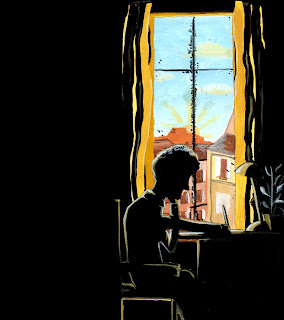YCN Briefs
House Of Illustration - War Horse
Penguin Random House Design Awards
Brief Box
11 Seconds Club
Loop De Loop
Secret 7
How to approach a vague brief?
Ask questions!!!
What's Involved specifically?
How many colours?
Any reference material?
how many pages?
how many characters etc?
Make sure you know exactly what is required for the brief.
Study Task 1 - Brief Selection - What is the Problem? (Part 1)
Secret 7
The substantial brief I am currently most interested in is Secret 7, which unfortunately is not live yet, however I am really excited to find out what the songs will be. I think the brief will be interesting in terms of pushing me out of my comfort zone, to create images for not only the songs I like, but songs that might be challenging to represent visually. I think this brief will allow me to fulfill several criteria for success within this module, as I feel that aswell as getting yourself public recognition, it is also to gain confidence with working to dimensions/specifications, and clients. This brief in particular will do all of those things, aswell as giving me an opportunity to exercise my creative skills for a live brief. As the actual brief/tracks have not been released yet, it is difficult to identify any problems at this stage, however I know that I will be designing artwork in response to 7 different tracks, in order for them to be printed, exhibited and sold to raise money for a charity.
Brief Box - Visual Identity for Painter & Decorator Alison
I feel really drawn to this brief, and is linked to the area of design/illustration that I am interested in. This brief provides the opportunity to design for a client with a requirement of reflected the clients interests, which also appeal to me; strong use of colour, geometry and pattern. In terms of fulfilling criteria for the module, It will once again provide exposure (not alot), but also give me experience in designing for clients. The main issues I am picking up from reading the brief, are that it is quite vague once again, and if this was an actual client I would want to meet them and get to know them as a person before giving them a visual identity. The brief does not specify the age of the client, or how long she has been painting and decorating for, which I think is another really important aspect that would need to be known in order to create a successful submission. Also there is no concrete deadline, which is clearly an issue.
Illustration Friday
Once again, not a hugely rewarding brief, but really great for generating work for my portfolio. I would ideally like to do a handful of these over the course of the module, and see how the subject matter effects my ways of working.
What is the problem? (Part 2) - Secret 7
- What problem(s) are identified by the brief?
Album covers for the 2016 tracklist for secret 7 need to be designed in order to raise money for charity (unsure what this year's will be).
- What is the brief asking you to do about it/them?
The brief is asking
- What is the brief trying to achieve?
Aswell as celebrating the successes of 7 musician/artists/bands, the competition aims to support charities and gain exposure for them, funded by people buying the artwork. There is a large sense of trying to revive the culture of vinyls and physical CD/album artwork.
- Who will benefit?
People effected by the disease that the charity supports, myself if I won as I would receive publicity.
- Who is the audience?
As the competition is quite well known, it is heavily received by music and art fans, aswell as the general public. Usually there are alot of established artists that enter the competition, creating more buzz.
- Can you foresee any problems in responding to the brief?











































